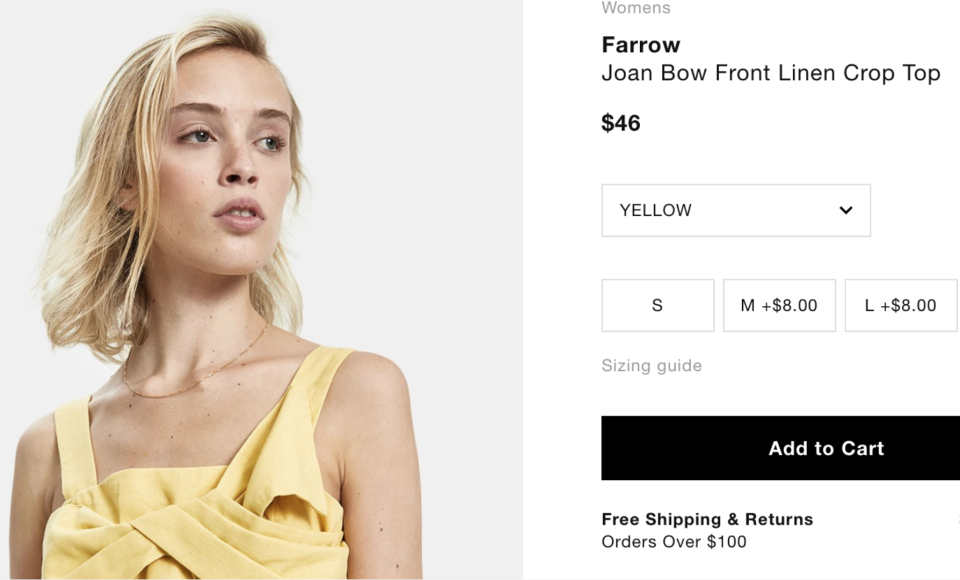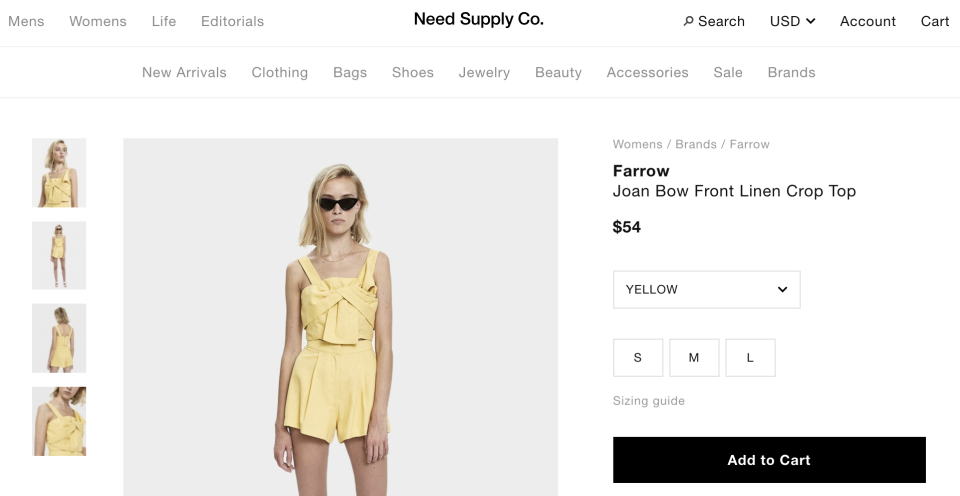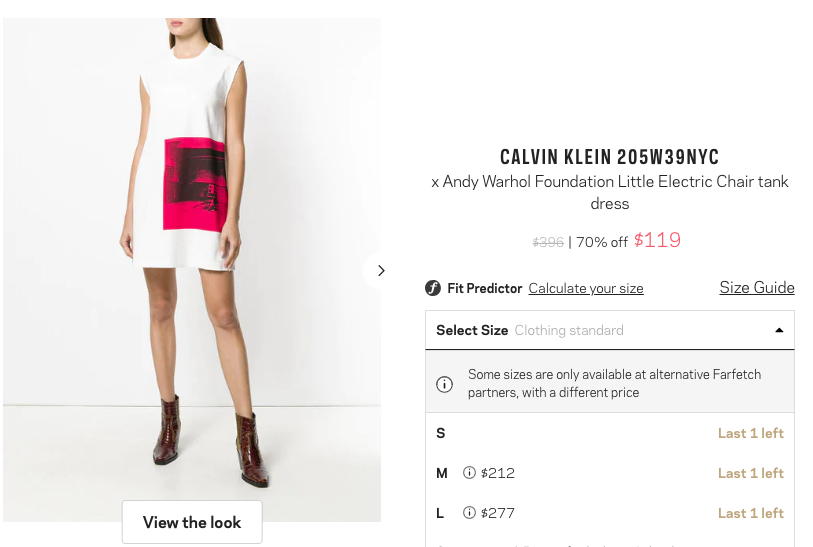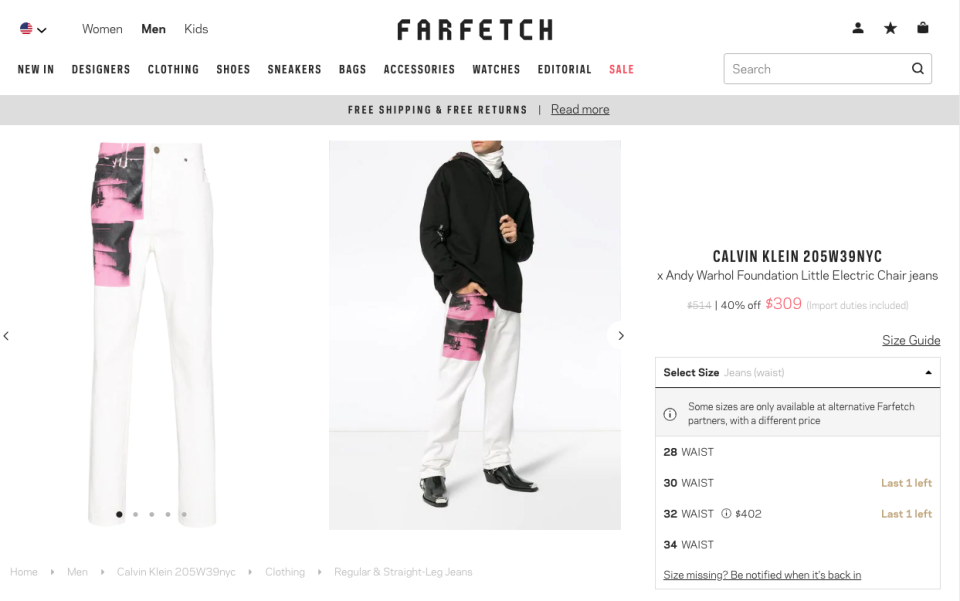Larger clothes sometimes cost more online. Is it price discrimination?

Shopping for clothes online has generally become a positive experience for consumers, as the saturated landscape drives retailers to offer everything from free shipping and returns to competitive pricing.
But sometimes the advertised price does not apply to all sizes. While not a new practice, Yahoo Finance has discovered that more e-commerce players are pricing larger sizes of products at a significantly higher price point.
Need Supply, a Virginia-based women’s clothing site that ships globally, advertised a crop top from its in-house brand Farrow for $46. But once you changed the sizing options, it was evident that the price only applied to a size small. The other two available sizes — medium and large — were listed for an additional $8. The screenshot above was taken on August 6.
Yahoo Finance reached out to Need Supply multiple times for comment. While Need Supply did not respond, two weeks later, when we checked the website on August 20, the site had raised the price of the shirt to $54, with no additional cost attached to the larger sizes.

“Typically, dynamic pricing is something you see when purchasing time-dependent items like airline tickets or concert tickets. However, I have yet to see examples of this in fashion. The area where dynamic pricing may be applicable in clothing is in fast fashion where products go in and out quickly,” said Brian Lee, associate director of research at retail consulting firm Gartner L2.
On many sites, the disparity in pricing is not immediately noticeable. Farfetch is a UK-based online platform that sells products from 900 luxury boutiques around the world. Several items on the site had a gaping disparity in pricing between the smaller and larger sizes.
A Calvin Klein x Andy Warhol tank dress is listed as “on sale.” This is true for size small, which is 70% off and goes for $119. However, no other size of the dress is on sale, the size medium goes for $212 and large for $277. The stealthy part of this pricing is that it’s only visible once you toggle to the size of your choice.

The site insists that being a third-party platform absolves it from the boutiques’ pricing structures. “Farfetch is not a retailer. It operates a marketplace platform on which boutiques and brands, which are selected to feature on the marketplace, set prices on their products for both full and sale price. Farfetch does not set the prices,” Giorgio Belloli, chief commercial and sustainability officer at Farfetch, told Yahoo Finance.
When asked about why the larger sizes are priced so much higher, Belloli blamed import duties and currency rates for fluctuating prices. “There can be instances in which different boutiques set different prices across products and sizes.” Ultimately, however, he said it’s not a size-ist practice and that consumers will continue to come to the platform for “a differentiated luxury experience.”
The discrimination debate
Tiered pricing is not a new practice, but it seems to be proliferating in the industry far more than in the past. While charging more for plus sizes has long been the case in men’s fashion (Big & Tall), it hadn’t permeated the women’s fashion industry in the same way.
Sites like Amazon use dynamic pricing models based on algorithms and availability, as previously reported. And sites like ASOS and Boohoo have been under fire for charging more for plus-size versions of the same items.
Maureen Mullen, co-founder and chief strategy officer of Gartner L2, believes the pricing structure is a product of supply and demand.
“Dynamic pricing on these sites is merely reflective of their inventory pools. As sites like Farfetch and Need Supply don’t actually “hold” or “buy” any inventory they are dependent on the size depth through the third party boutiques that are listing products on their sites as well as prices they set,” she said.
There are examples where it’s not just the smallest sizes that are the cheapest price. A pair of men’s jeans from the same Calvin Klein x Andy Warhol collection on Farfetch are billed as 40% off. While waist sizes 28, 30 and 34 are $309, and size 32 is $402.

“There isn’t distinct pricing discrimination going on here; rather this would suggest that they have smaller SKU [an ID code that allows an item to be tracked for inventory management] depth in particular sizes because boutiques are likely either buying less or selling more via other channels,” explained Mullen.
“This doesn’t feel like any overt discrimination is taking place, however, likely many of these third party boutiques (that often lack sophisticated planning tools) are still right sizing their assortment to match today’s customer.”
Keith George, co-founder and CEO of plus-sized women’s clothing site CoEdition, believes “this is discrimination at its base form.”
Prior to starting CoEdition, which only offers sizes 10 to 26, George was an executive at Gilt.com and Gap. Unfair pricing is one of many reasons he felt compelled to build a company that focused solely on plus-sized women, who have long been alienated in the fashion industry.
“On our sites, pricing is standard and uniform. There are a lot of things that go into producing a garment, but materials and labor associated with size are not material to driving the cost. For us, it’s important that pricing is standard and consistent,” he said.

‘Pricing should be standard across the board’
“I understand that historically for brands, they tended to shy away from plus sizes because they thought that the costs were higher. They thought they had to have a new fit model for this customer, but this is the majority of women in America. Everything that goes into the cost, like materials, labor, branding, store, have nothing to do with the size of the customer. We come back to being size inclusive, putting the majority of women front and center. Pricing should be standard across the board,” he added.
E-commerce facilitates this ability for retailers to offer tiered pricing. While a consumer may be outraged at seeing a medium-sized item priced differently than a small-sized of the same item online, she likely would just move on or tweet at the retailer. It’s hard to imagine how sales associates in brick-and-mortar stores would respond to customers wondering why there’s such stark differences for a larger article of clothing.
Given that e-commerce now accounts for 13.3% of all retail sales in the U.S., it’s clear that the market share of online shopping will continue to grow. But as sites continue to keep up with demand, they should price with caution.
Dynamically pricing products based on sizing seems a dangerous path to go down due to the potential backlash that might outweigh any sort of gain,” said Lee.
Melody Hahm is a senior writer at Yahoo Finance, covering entrepreneurship, technology and real estate. Follow her on Twitter @melodyhahm.
Read more:
Millennial men prefer to buy just about everything on Amazon
This $1500 mirror works as a personal trainer
Men and women aren’t that different: investing app Stash
RVs and recliners are back thanks to millennials
Anaheim wants to be the Disneyland of beer

 Yahoo Finance
Yahoo Finance 